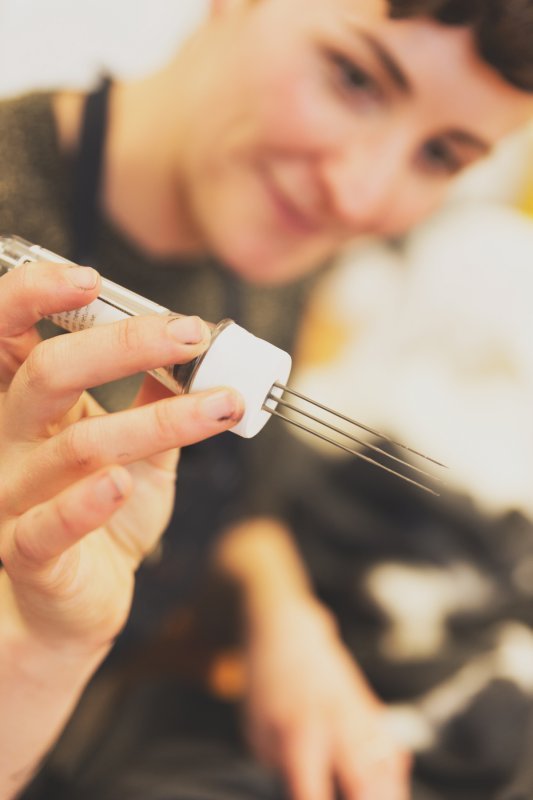Long Coat
The Long Coat is based on the same pattern as both the Cropped Tshirt and the Long Tshirt. The only deviation is collar/neckline selection. Once you understand the Tshirt, this coat is easy!
Considerations
The width of the cloth is approximately the circumference of the garment around the body. If you want a more voluminous form or are a larger size go for a wider cloth, likewise with you want a more fitted silhouette.
Recommendations
The drape or stiffness of the cloth will alter dramatically the final look of the garment. You can use a softer cloth such as a silk twill to achieve a fluid drapey look, similar to a kimono, or use a firmer fabric such as a heavy linen or wool.
The Long Coat shown in the photo is made of end-of-roll wool melton (felt). The nature of felted fabrics mean that edge finishing isnt required in every case, however all the edges can be pre-finished using digital or machine embroidery or acrylic house paint, all joins are needle felted and the form is modified through the body rotation. The shirt in the photo uses 140cm of 155cm wide Wool Melton. The model is a NZ size 10

Making the Long Coat
There are three methods of using the Make/Use system - Pattern, Print or Template:
Pattern
Simple line diagram to print onto paper at full scale – the closest to using a traditional dressmaking pattern. Good if you have fabric at the exact width or know how to use software to change the pattern to fit. Available as ai file (Adobe illustrator/Inkscape for modifications), or pdf. Print tiled and stick together, or take to a large format printer.
Print
Screen printing or digital printing files to put the patterns directly onto fabric. Good if you want a printed garment, some of the guide for making the garments are embedded in the print file to enable an easier understanding of the making process. Can be expensive.
There are no print files available for the Long Coat
Templates
Lasercut templates printed onto rigid paper or card that allow a maker to draw required patterns onto fabric. This is a modular system that enables a Make/Use garment to be made from any width fabric. Low cost if using printed method, great for students of all ages and home sewers.
Making the Long Coat from a pattern
You will need: 140cm long of ~155cm wide cloth, a pattern printed at 100%. If you want to make a coat from fabric that is not 155cm wide you will need to modify the pdf to fit or use the Template method.
You can print the file as is from the pdf and set your printer settings to 'tile', and 100%, tape your pieces together and you have a full scale pattern. You can also open and modify the pattern in Illustrator, Inkscape or any similar vector based program to fit the width of fabric you want to use. If you do that, be careful to not select the neckline before stretching/shrinking it to fit the new width.
This garment can be made from any width cloth, remembering that the width of the cloth determines the circumference of the garment assuming you don’t make any additional modifications to the design such as pleats/gathers etc, and also determines the span from sleeve hem to sleeve hem.
Find a fabric you like the look and feel of, make sure it is something you can sew based on your abilities and equipment, and away you go!
Downloads
Long Coat Pattern PDF
Making the Long Coat using Templates
You will need a fabric of your choice, approximately 140cm long. A4/A3 printer or Lasercutter, Paper or card for making templates.
Each Make/Use garment made in this method is unique to both the fabric and the user. The length of a Make/Use Long Coat can be altered to suit an individual's height or taste; a favourite fabric can be used to make the Long Coat and drastically alter its appearance; new iterations can be created by combining templates in ways dreamt up by the maker/user. The possibilities are literally endless.
- Using the Long Coat Grid file as a guide, mark half way between edges of fabric for Fabric Centre Line and ¼ Fabric Width (A) either side of this.
- Measure on your body the desired depth of sleeve (B) from your own shoulder down - this begins to determine how wide your sleeve is on your garment
- Measure on your fabric 1 x B to Shoulder Line, and 1 x B from Shoulder Line to Sleeve Depth.
- Finally measure from shoulder to finished desired length and then minus B, for C.
- Mark out C to determine finished length of Tshirt
- The intersections of Fabric Centre Line and Shoulder Line, as well as ¼ fabric width and Sleeve Depth are key anchors for placing the templates.
- Body Rotation template can be placed any where between Sleeve Depth and hem of garment. Sleeve swap can be placed anywhere between Shoulder Line and the top cut of garment flat.
Print: Print out using a standard printer the files only A4 and/or A3 paper or card and cut out the dotted fill. Follow the instructions on the pages
Lasercut: Download files and have laser cut on 2mm card according to lasercutter specifications.
- Line up desired templates with grid and follow instructions printed on them. Mark horizontal and vertical lines with tailors chalk.
Downloads
Print files (pdf):
Print template: collar neck
Print template: round neck
Print template: wide neck
Print template: sleeve cut (left)
Print template: sleeve cut (right)
Print template: body rotation (left)
Print template: body rotation (right)
Print template: elbow rotate (left)
Print template: elbow rotate (right)
Print template: shoulder rotate (left)
Print template: shoulder rotate (right)




















